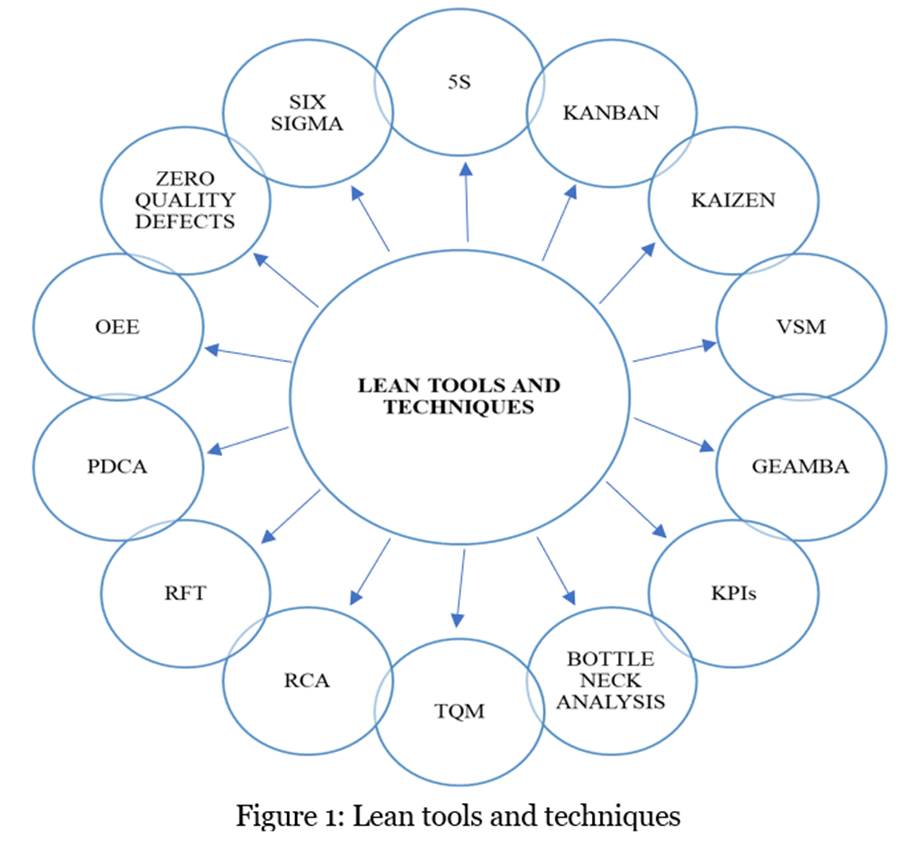Lean manufacturing is the most widely used methodology by various business sectors and manufacturing industries. This article explores the essence of lean manufacturing, its techniques, and their impact on textile-based garment production. Many business sectors and manufacturing industries have adopted lean tools and techniques to improve their productivity and efficiency, which ultimately improve their profitability rates. After the implementation of lean manufacturing, industries start adopting various advantages and benefits that will enhance growth in the competitive market. Apparel product manufacturers must focus on improvement in product quality, overall production speed, and operational efficiency to keep their position at the best level and also for the creation of pace in a competitive industry.
Lean Manufacturing
Lean manufacturing is a wider and endless concept that was started by Toyota’s production system which is also called TPS. Toyota’s production system was first used in an automobile manufacturing industry known as The Toyota Way in the US. The first operational model was implemented in post-World War 1950-60 in Japan at TPS. This concept of lean manufacturing was based on two main pillars which are JIT (Just-In-Time), the inventory management system and JADOKA which means Automated Quality Control. The actual concept of lean manufacturing is to deal with the reduction and elimination of wastage from the ongoing processes.1 This wastage is divided into three different categories namely,
• Muda – Wastefulness
• Mura – Unbalancing
• Muri – Overload or Overburdening
These wastages are considered dangerous in the context of lean manufacturing. Implementation of lean tools and methodology reduces and eliminates these various wastages and serves the continued growth of the organisation.
In the apparel industry, lean manufacturing, which focuses on lowering production costs, improving overall output, and minimising production times and total lead time, may be the answer. This concept guarantees significant advantages, such as increased productivity, reduced lead times from raw material sourcing to the finishing of goods, shorter cycle times, enhanced product quality, and ultimately, increased profitability.2
Lean Tools and Techniques
In garment production, lean manufacturing requires a healthy and lean culture and the implementation of lean tools. In the apparel industry, the VA activities stand for value-added activities, which means the transformation of raw material goods into the finished product that the customer wants, without any waste. These wastages vary depending on the type of department and type of ongoing activity. Individuals can implement lean tools and techniques to reduce work-in-process (WIP) time, minimise production costs, reduce time loss, and improve profitability. However, the whole organisation needs to be involved in discussions to understand the importance and approach of lean tools. So, these are applied to improve manufacturing operations of garment production.2,3 Now let us understand the important tools and techniques of lean manufacturing,

1. 5S
The 5S is the most basic and important tool of lean. It is called the first step of implementing lean manufacturing. It provides serval benefits to the organisation and workplace by keeping cleanliness. 5S implementation in the garment production process is nothing but the ultimate tool for continuous improvement.3
The process of implementing 5S is given below:
• Select a workplace to implement 5S.
• Make a list of all the items, pieces of equipment, machines, materials, booklets, paperwork, documents, and other things.
(Note: The list of items or materials will vary from department to department)
• Now do the first step of 5S which is SORT.
• SORT the things based on Necessary items and non-necessary items.
• Then implement the second step of 5S which is SET IN ORDER.
• Now keep the items based on Regular (Daily) use, monthly use, yearly use etc.
• Set the items as per the convenience and preferences of use or application.
(Note: One can add labels, names, or numbering of items, it will help to understand the workplace better)
• After implementing these two S, focus on third S which is SHINE.
• SHINE means cleanliness or cleaning. Keeping the workplace clean and shiny is the objective of this S.
(Note: A daily or monthly calendar of SHINE can be created)
• Standardisation, this is the fourth important tool of 5S. After implementing the above three S. Now there is a primary responsibility of Standardisation. All the team members or the employees working in their respective departments have to take care of standardising the above three steps. Create a habit of it. This lean tool creates a consistent way of doing things and it maintains all the activities, monitoring is also an important step under 5S.
• The last step is Sustain. Sustaining the 5S system is the last but very important. Sustaining the above four steps with consideration of sustainability is also important. It simply means following the good practices going over time.
So, by implementing the above steps a better and healthy workplace can be achieved.
2. Kanban Board
Kabana is a Japanese word that means visual representation, or visual display board. Kanban boards are mostly used for visualising to do list, and commands related to different activities like, what to do, what is done, and others. They are used in the apparel industry to reduce overproduction on the manufacturing floor, helping to eliminate excess production of goods and create a smarter plan to achieve higher efficiency on the sewing floor.
3. Kaizen or Continuous Improvement
Kaizen is the most commonly used and most popular lean tool. It means continuous improvement or change for betterment. It is a simple philosophy, but it has a never-ending approach and applications. Kaizen in apparel industries’ is used for improving ongoing efforts, improving productivity, and strengthening services or processes. At the end of its implementation, one can seek ‘incremental’ improvement over some time.
4. Value Stream of a Product
VSM in lean stands for Value Stream Mapping. It is one of the popular techniques of lean manufacturing and is widely used for documentation, analysing and improving process flow, and improving man and material movement. VSM also provides information related to materials produced like WIP (work in progress) of different departments, ready-to-sew, ready-to-ship, and others.
5. Gemba
Gemba is another Japanese term that represents a problem-solving approach by visiting or attending to the actual place where a problem is occurring. A Gemba walk involves various processes and a series of activities, such as asking and collecting the right information from the root cause area. It is considered the best way to solve real problems, as it entails physically being at the location rather than sitting in an office and depending on others to collect data before taking corrective actions. The Gemba team understands the problem and subsequently implements the right tools or techniques to address it.
6. KPIs
KPIs, also known as KRAs (Key Result Areas), are highly important in any manufacturing organisation. They are tools used for measurement to understand a company’s current situation, enabling them to focus on implementing new practices to achieve their next goals. KPIs vary from department to department and from one organisation to another. Without KPIs, it is challenging to sustain competitiveness in the business world. They assist in achieving goals through a problem-solving approach.
7. Bottleneck Analysis
Bottlenecks are operations where the required outputs are not generated efficiently or as per capacity. In the production of garments, bottleneck operations can significantly impact the total productivity of the sewing floor. Therefore, eliminating bottleneck operations is a crucial step. To achieve this, bottleneck analysis is carried out in the sewing and finishing departments with the aim of removing operations that hinder the production flow.
8. Total Quality Management (TQM)
TQM is a powerful technique for quality improvement. Total Quality Management is a lean management approach that focuses on quality assurance and quality control of goods, centralising quality. It aims to achieve optimum quality and, consequently, customer satisfaction. However, the implementation of TQM requires a longer time period, extensive teamwork, leadership qualities, team building, and management involvement, especially from top management.
9. Root Cause Analysis
RCA in the apparel industry stands for Root Cause Analysis. It employs a problem-solving approach. This tool mostly works on the principle of identifying the root causes of problems, and various departments use this methodology to identify and solve the problems permanently. In the apparel industry, industrial engineers, the quality department, the finishing department, and even the merchandising department adopt this tool to address and eliminate problems through the implementation of lean tools and techniques.
10. Right First Time (RFT)
RFT is a tool that ensures the quality and production of apparel goods. Simply put, it is a quality improvement tool. In the apparel industry, everyone focuses on achieving a certain level of right the first time.
11. PDCA
Lean tools always aim to eliminate hazardous waste from the production process. PDCA stands for Plan, Do, Check, Act or Adjust. These four steps are part of a management process that assures quality standards and focuses on continuous improvement. Planning is the most important step in solving any problematic situation, and taking corrective action based on the problem is ‘Do’. After implementing the corrective action, checking or cross-checking is also important. In the last step, action or adjustment based on the result is necessary. If the outcome is different than expected, then cycling through these four steps is necessary until the desired results are achieved.
12. Overall Equipment Effectiveness (OEE)
OEE is one of the best lean techniques for assessing a manufacturing process’s productivity. It is defined in terms of percentage. If OEE is 100 per cent, the manufacturing factory is considered fully productive. It also indicates that the produced goods meet the highest quality standards, and there are no idle processes. However, if OEE is 50 per cent, it signifies that various factors are affecting the quality and performance, prompting the need for process improvement.
13. Poka-yoke (Mistake Proofing)
Poka-yoke is a Japanese word which means mistake-proofing or error-proofing. These tools help to reduce and eliminate mistakes throughout the manufacturing process and aim to achieve high-quality levels of the goods. Poka-yoke is a quality control technique.
14. Zero Quality Defects
This technique of lean is not easy to implement, but after the successful implementation, the industry can achieve all the possible outcomes related to product quality and service. Zero quality defects involve maintaining a process with no defects, and it can be achieved through 100 per cent production inspection.
15. Lean Six Sigma
Six Sigma is a tool which has a data-driven approach and is mainly implemented to reduce defects and variations throughout the manufacturing processes. It uses statistical methods to deal with achieving high levels of quality and consistency while manufacturing apparel products or goods. Lean Six Sigma is widely used in apparel and other industries to enhance quality, reduce costs, and increase customer satisfaction. It is the best and most powerful tool for organisations seeking to optimise their operations.
Benefits of Lean Implementation
• Different tools and methodologies of lean aim to ‘improve productivity and quality of apparel products’.
• The primary objective of lean projects is to ‘eliminate waste and problems’.
• Tools like 5S, JIT, and kaizen ‘reduce the Work in Process (WIP) inventory from the respective departments.
• Implementing appropriate lean techniques ‘reduces inventory area, overall cycle, and total lead time’.
• It smoothens the production flow at ‘controlled manpower, through utilising time and space’.
• Kanban boards and systems improve the ‘visual management system’ in the workplace and organisation.
• Right lean approach can ‘reduce machine downtime, the total cost of manufacturing and regular maintenance problems’.
• It ‘optimises resources, sustainability, employee satisfaction, and increases profit’.
• Lean highlights the ‘efficiency gains achieved through streamlined processes, resulting in faster production cycles’.
• And last but not the least ‘improved customer satisfaction’ by providing goods with optimum quality, at higher efficiency, which provides customer satisfaction and increases the rate of profitability.3
Conclusion
In today's world, garment manufacturers are increasingly focusing on the systematic reduction of waste to enhance productivity at elevated production rates. In this regard, lean manufacturing emerges as the most intelligent approach for apparel manufacturing companies looking to manufacture goods more efficiently and economically. This strategy has its origins in Toyota’s production system in Japan, where the innovative concept of waste reduction in manufacturing processes was pioneered many years ago.
The methodology involves various tools and techniques, including sorting and setting in order, meticulous planning, and achieving pre-defined process goals step by step. By leveraging these tools, manufacturing organisations can expedite the production process, enhance quality, and diminish costs.
Implementing a lean approach enables manufacturers to deliver goods and services swiftly, consequently enhancing customer satisfaction. Ultimately, lean manufacturing aids garment manufacturers in bolstering their profitability through efficient operations and the production of high-quality products.






_Big.jpg)





Comments